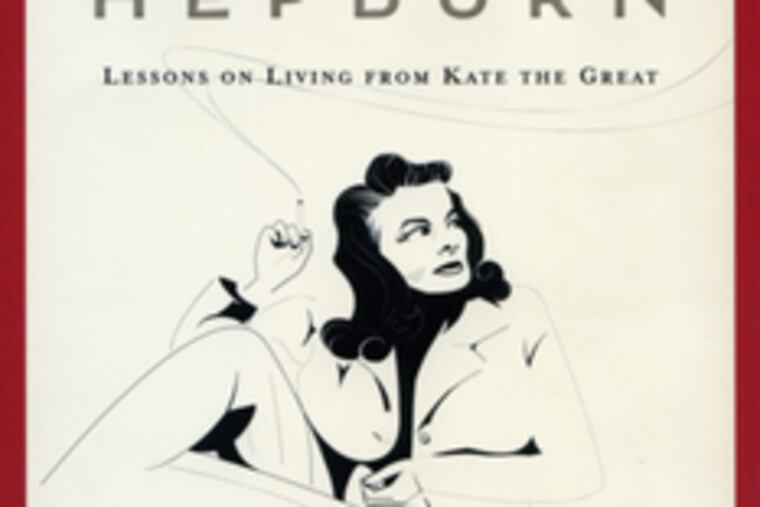What Kate could teach us
Author gleans self-help lessons from the life of the screen legend.

Lessons on Living From Kate the Great
By Karen Karbo.
Bloomsbury. 208 pp. $19.95
nolead ends nolead begins
Reviewed by Paula Marantz Cohen
Katharine Hepburn died at the age of 96 in 2003.
How to Hepburn: Lessons on Living From Kate the Great
has been published to coincide with what would have been her 100th birthday last month.
Karen Karbo's scrappy little book chronicles the nodal points of Hepburn's life and career, rehashes some of the more famous anecdotes about her, adds a generous dollop of lighthearted analysis, and inserts numerous bulleted, numbered, and italicized lists of Hepburn's habits, pastimes and opinions. It is hagiography with a touch of self-help - hence the title. Karbo wants to see her idol's name become a verb.
One list that she offers up is titled: "A Primer on How to Be a Class Act." It begins: "No matter what, maintain your own address, where your toothbrush and your paid live-in companion and cook reside." Another list contains "Tips for Getting Your Hepburn On" - "Have a Credo," "Find Yourself Fascinating," "Find a Sport(s)," "What You Think," etc. One of the last lists is actually a quiz: "Test Your Ability to Make Denial Work For You," which, when scored, tells you if you have the capacity to be a "Hepburnian Stoic."
Karbo also gives us lists of the "rules Hepburn did not obey" and "the acts of brashness" she committed (skinny-dipping in the fountain at Bryn Mawr during her college days, sneaking out of the UCLA Medical Center at 4 a.m. after hip replacement surgery).
For some readers, a little of this will go a long way, but for others, Karbo's factoids and musings will be a source of joy. Some of us just can't get enough Hepburnisms. We want to know how a young woman with sharp elbows, too many freckles, and an affected accent managed to transform herself into a cultural icon. Was Hepburn a man in a woman's body? An amazon? An androgyne? "Long before Gloria Steinem observed that on some level all women are female impersonators, Hepburn was unwittingly showing it to be true," Karbo notes.
There are ruminations on Hepburn's proclivity for trousers, eschewal of makeup, athleticism, friendships, and work ethic. There are riffs on her stage and movie career, and her devotion to the boorish married man with whom she starred in nine movies between 1942 and 1967. Spencer Tracy was allegedly the love of Hepburn's life, but he was a handful. Asked why he was billed above her in Woman of the Year, he brusquely replied: "This is a movie, not a lifeboat."
The idea of writing a "how to" book based on someone as inimitable as Katharine Hepburn seems a contradiction in terms. It is unlikely, for example, that we would want to imitate her and fasten our pants with a large safety pin when we lose a button.
But some of Kate's behavior is worthy of imitation. She embodied many of the lessons that the New Age gurus teach us today: Stick with your beliefs, love whom you choose, be comfortable with your body, dress as you please. She was ridiculed and insulted amply throughout her career - referred to early on as "a cross between a monkey and a horse," shunned for a time by the studios as "box office poison," accused of being talentless. (Dorothy Parker's famous quip was that her acting "ran the gamut of emotions from A to B.")
But none of this got her down - or if it did, she didn't show it. Instead, she used her weaknesses and eccentricities to build her persona, surpassing Bette Davis and Joan Crawford, and joining Bogart, in the highest strata of the star firmament. Eventually, everything about her came to contribute to her iconic image. Even her late-life tremor seemed distinctively Hepburnesque.
"Our entire perception of the lady strains the limits of postmodernism," Karbo says of her subject. Hepburn was indeed a postmodern woman avant la lettre. A self-conscious bricolage of mannerisms and habits, she merged the traditional and the progressive, the glamorous and the dowdy, the practical and the nutty. She broke with convention while remaining somehow known and comforting. "Hepburn was not a feminist. She was a Hepburnist," Karbo pronounces.
Don't buy this book in the hope of learning much that's new about Katharine Hepburn; you probably know most of what Karbo has to say already. Buy it if you want to trek through familiar territory and be reminded of the Hepburnisms that have become embedded in our national lore. No revelations here, just an exuberant celebration of a great original. You can give the book to your mother for Mother's Day or keep it for light reading in the bathroom. That's where Hepburn might have put it.